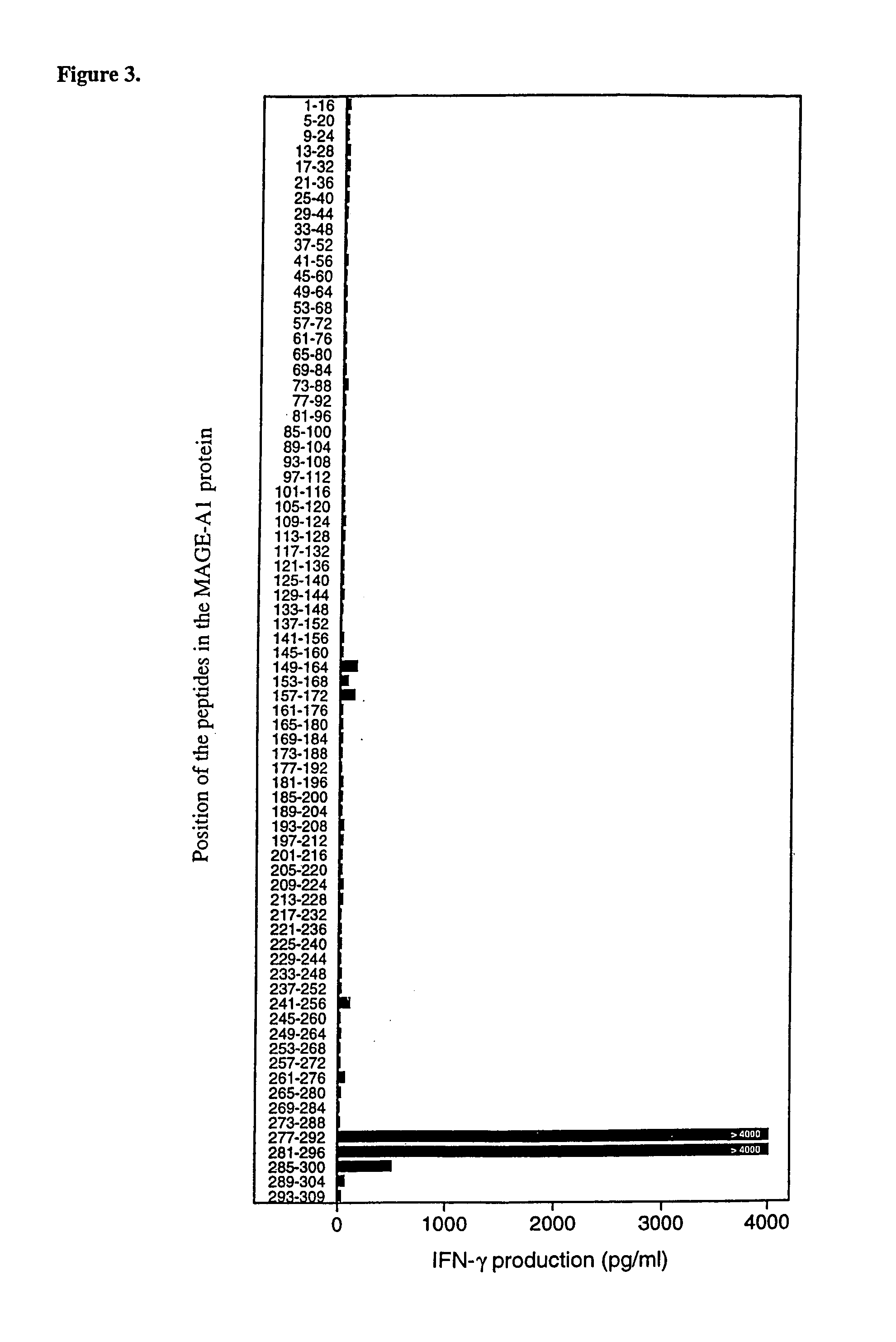MAGE-A1 peptides presented by HLA class II molecules
a gene product and peptide technology, applied in the field of magea1 fragments of tumor-associated gene products, can solve the problems of poor tumor-specific immunity, complex process by which the mammalian immune system recognizes and reacts to foreign or alien materials, and lysis of tumor cells, and achieve the effect of promoting the activation and proliferation of cd4+ t lymphocytes
- Summary
- Abstract
- Description
- Claims
- Application Information
AI Technical Summary
Benefits of technology
Problems solved by technology
Method used
Image
Examples
example 1
Identification of a MAGE-A1 Epitope Presented by HLA class II Molecules to CD4+ T Lymphocytes
[0108]Monocyte-derived dendritic cells were loaded with a MAGE-A1 recombinant protein and used to stimulate autologous CD4+ T cells. A CD4+ T cell clone was isolated that recognized peptide MAGE-A1281-292 (SEQ ID NO:7) presented by HLA-DRB1*15 molecules, which are expressed in 17% of Caucasians.
I. Cell Lines, Cytokines
[0109]EBV-transformed B (EBV-B) cell lines were cultured in Iscove's modified Dulbecco medium (IMDM) (Gibco BRL, Gaithersburg, Md., USA) supplemented with 10% foetal calf serum (FCS) (Gibco BRL), 0.24 mM L-asparagine, 0.55 mM L-arginine, 1.5 mM L-glutamine (AAG), 100 U / ml penicillin and 100 μg / ml streptomycin. Human recombinant IL-2 was purchased from Eurocetus (Amsterdam, Netherlands), IL-7 from Genzyme (Cambridge, Mass., USA), GM-CSF from Schering Plough (Brinny, Ireland) and TNF-α from R&D Systems (Abingdon, UK). Human recombinant IL-4, IL-6 and IL-12 were produced in the la...
example 2
Recognition of Other MAGE Proteins by Clone 14
[0126]Peptide sequences homologous to the MAGE-A1 HLA binding peptides described herein are found in other cancer antigens including MAGE-A4. For example, MAGE-A4 peptides were synthesized: YVKVLEHVVRVNARVR (SEQ ID NO:13) and LEHVVRVNARVRIAYP (SEQ ID NO:14). To determine if the CD4+ T cell clones recognize these MAGE-A4 peptides, the peptides are used to load antigen presenting cells (such as EBV-B cells) to test for recognition by clone 14 according to the assays described above. To determine if the CD4+ T cell clones recognize additional cancer associated antigens, the recombinant proteins (e.g. MAGE proteins) or other synthetic peptides corresponding to the homologous region in these proteins, are used as described above. Homologous peptides which are recognized by clone 14 may be regarded as functional variants of the MAGE-A1 peptides described herein.
[0127]Other aspects of the invention will be clear to the skilled artisan and need ...
PUM
| Property | Measurement | Unit |
|---|---|---|
| temperature | aaaaa | aaaaa |
| concentration | aaaaa | aaaaa |
| concentration | aaaaa | aaaaa |
Abstract
Description
Claims
Application Information
 Login to View More
Login to View More - R&D
- Intellectual Property
- Life Sciences
- Materials
- Tech Scout
- Unparalleled Data Quality
- Higher Quality Content
- 60% Fewer Hallucinations
Browse by: Latest US Patents, China's latest patents, Technical Efficacy Thesaurus, Application Domain, Technology Topic, Popular Technical Reports.
© 2025 PatSnap. All rights reserved.Legal|Privacy policy|Modern Slavery Act Transparency Statement|Sitemap|About US| Contact US: help@patsnap.com



